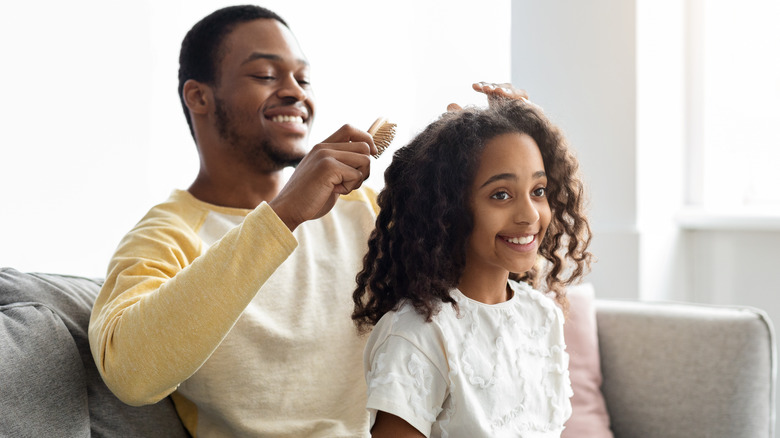What Really Happens When You Stop Brushing Your Hair
Whether you've got a head full of curls that frizz out whenever you take a brush to it or you are just too busy to be bothered with brushing your hair every day, there are some things you should know should you choose to avoid the hairbrush.
The effects of not brushing your hair look different for everyone as it's dependent on your hair type. In many cases, though, you might be looking at built-up grease and extra shedding — plus some potential extra volume (via Bustle).
If you're someone with curly hair, you probably already know that it's recommended you don't brush your hair, at least not when it's dry. "Once dry, it can be quite painful to try to brush out," hairstylist Dionne Smith told My Imperfect Life. "Using water and/or a good water-based detangling product helps to comb through hair and untangle it a lot more easily."
Benefits of brushing
When you stop brushing your hair, you risk grease buildup at your roots. Regularly brushing your hair helps to distribute the oils that naturally build up in your hair follicles (via Shape). This helps keep your glossy and healthy, as your dry ends are able to soak up all that extra oil.
Not brushing your hair may also lead to some plumbing issues. According to the American Academy of Dermatology Association, we naturally lose about 50 to 100 strands of hair every day. Brushing your hair helps to remove these stray hairs that may otherwise fall out as you're washing your hair in the shower. While there are definite benefits to brushing your hair, you still shouldn't overdo it.
Celebrity hairstylist Vincent De Marco told Healthline, "Vigorous brushing, even if only once a day, will cause breakage and damage your hair." Depending on your hair type, he states that gently brushing your hair twice a day is sufficient. Either way, make sure you are treating your strands with care.
How often should you be brushing your hair?
There is no one-size-fits-all answer for how often you should brush your hair. People used to swear by 100 strokes a day, but hair wisdom has evolved over the years. Nowadays, you'll want to consider other factors to establish a good brushing routine. Board-certified dermatologist Dr. Nianda Reid suggests taking into account your personal preferences and hair type to help determine the right brushing frequency (per Byrdie).
When it comes to brushing benefits, Healthline points out that it can help distribute the natural oils from the scalp throughout the hair. But it may not be as beneficial for those with fine hair. That's because fine hair (whether it's wavy or straight) requires gentleness to prevent breakage and damage, so you'll want to brush cautiously (per Shape). Thick and medium hair handles regular brushing extremely well. But if you have luscious curly locks and coils, you may have different needs.
For curly and coily hair, it's safe to brush through those curls. But rather than brushing daily, your brushing routine is dependent on wash days. Consider brushing three to seven days on wash days only, professional hairstylist Michelle O'Connor tells Byrdie.
How to properly brush your hair
While it may seem counterintuitive, brushing techniques don't start with a brush. Some hair experts believe the key to hair brushing bliss starts in the shower (per Byrdie). Paying attention to your hair in the shower may help prevent breakage and tangles, regardless of your hair type and texture. Rather than primarily focusing on shampooing and conditioning, try not to tangle your hair in the first place, explains Shab Reslan, a certified trichologist and hairstylist. But if you accidentally tangle it, don't worry. Gently use your fingers to untangle your hair before hopping out of the shower. And if you have curly or coily hair, the shower journey doesn't stop there.
Curly and coily hair tends to be dry and brittle, so it needs to be brushed wet (per Bustle). This can be done before shampooing your hair and again after you condition it, points out Byrdie. To start, section your hair so you're able to fully detangle every area. "Working from the ends work your way up to the crown as brushing or combing any hair type of can cause breakage at the roots," celebrity and editorial stylist Michelle Swiney tells Bustle.
The technique of starting from the ends can also be used on fine hair. Celebrity stylist Mia Santiago tells Shape this technique helps prevent hair damage and loosens tangles in fine hair. For thick hair, Santiago recommends brushing through the tangles while holding your hair in a loose ponytail.
Should you brush it wet or dry?
There's something soothing about brushing your hair in the shower. It's like a gentle head massage that relaxes you. But should everyone do it if they want healthy hair?
In general, wet hair tends to be extremely fragile for some hair types because it's in a more fragile state. "Brushing it in that condition can actually over stretch, over pull, and ultimately tear your hair. Hair is in its strongest state when it's dry," Reslan explains to Byrdie. In fact, wet brushing can cause more harm and tangles to straight hair. With that being said, dry brushing before hopping in the shower may be best to minimize damage and properly detangle hair (via The Greatist).
On the other hand, for curly-haired folks, Dr. Reid explains that hydration prevents trauma to the hair and scalp while also preventing damage to the curls (per Byrdie). It's important to be gentle and use specific tools to help detangle the hair. Healthline suggests using a wet brush or wide-tooth comb to work in the leave-in conditioner or detangler to help remove tangles.





